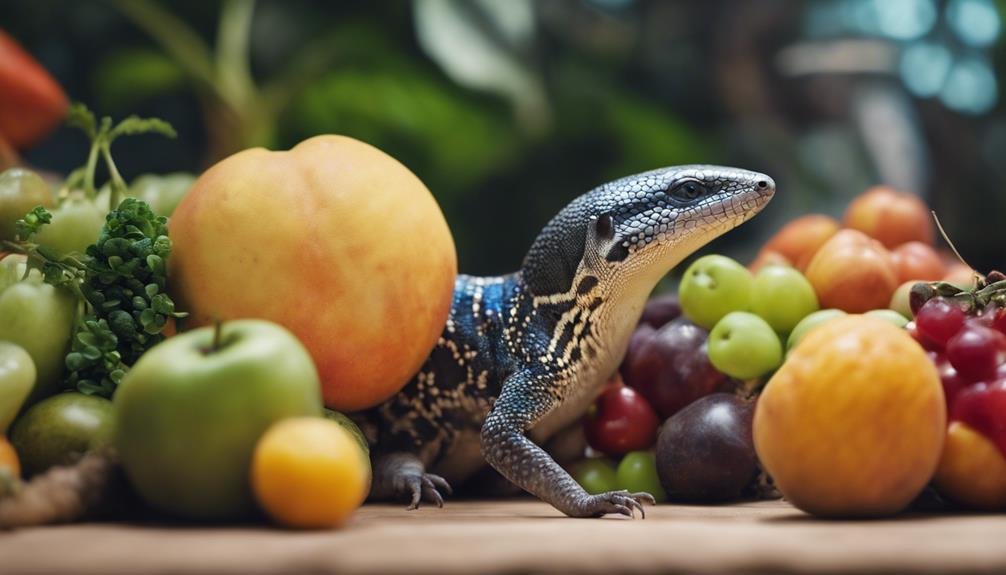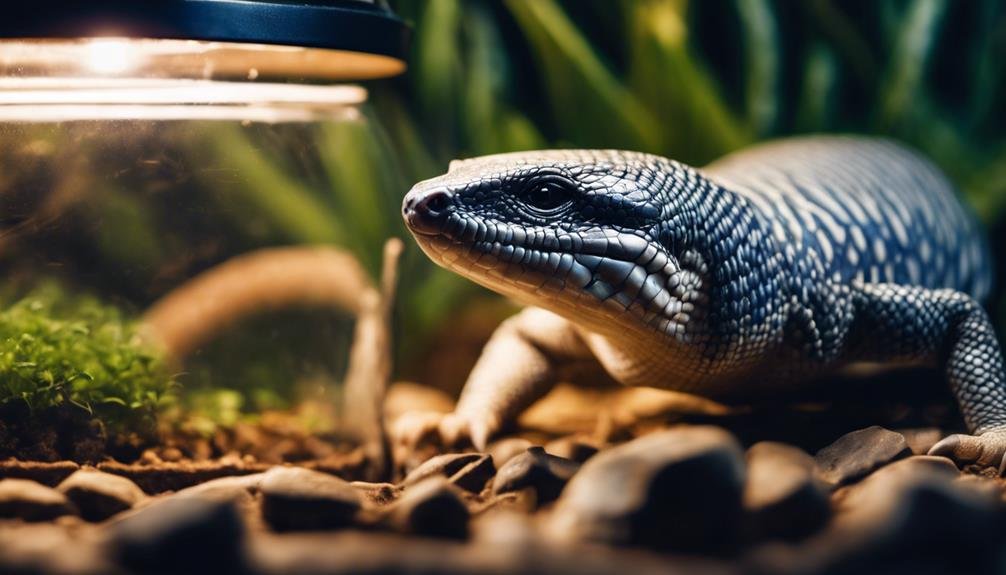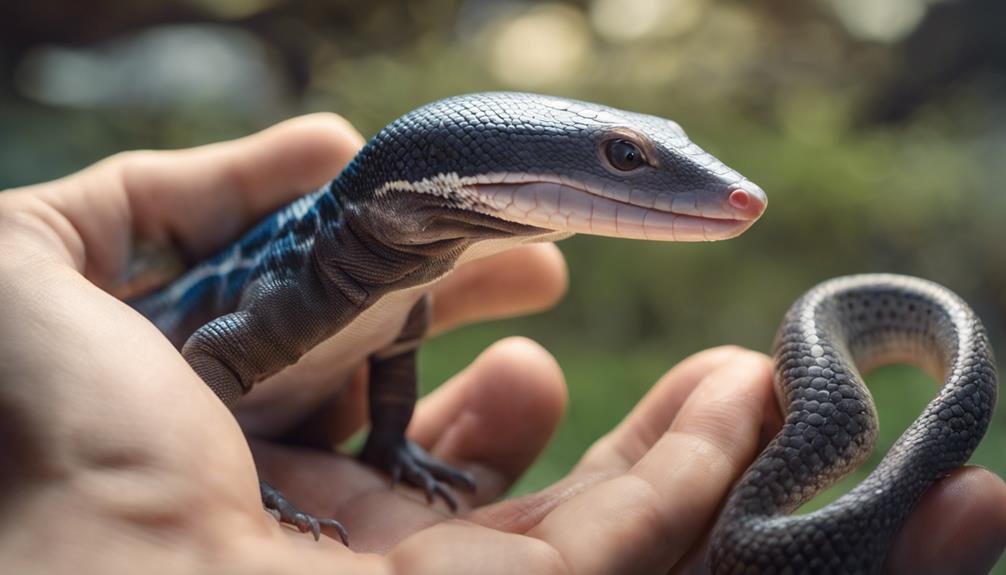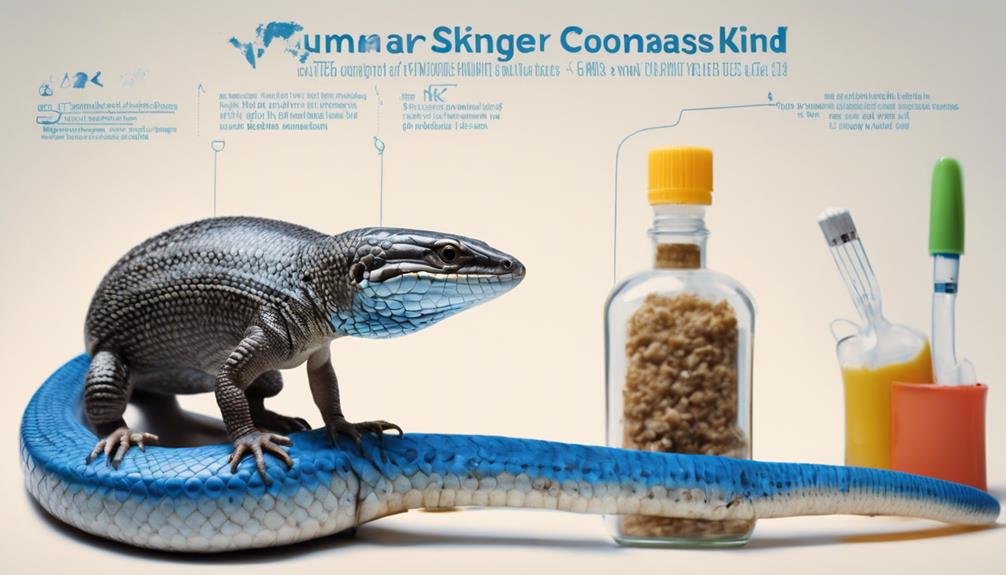You’re likely curious about the size your blue tongue skink could reach and how to care best for it to ensure it thrives. With adults typically growing between 18-24 inches, it’s not just their intriguing blue tongues that catch attention but their notable size. However, reaching this potential isn’t just a matter of time; it involves understanding their needs, from the best diet to the precise environmental conditions. Why is this meticulous care essential, and how does it influence their growth and health? Let’s explore the key factors contributing to these unique reptiles’ well-being, ensuring they grow and flourish under your care.
Key Takeaways
- Adult blue tongue skinks typically range from 18-24 inches in length.
- Juvenile skinks start at 6-8 inches, with growth influenced by genetics and diet.
- A minimum enclosure size of 4x2x2 feet is recommended for their well-being.
- They require a balanced diet of 60% plant-based foods and 40% animal protein.
- Proper heating with a basking spot of 90-95°F and full-spectrum UVA/UVB lighting is essential for health.
Understanding Blue Tongue Skink Sizes
When considering a blue tongue skink as a pet, it’s important to understand that adult sizes can range from 18-24 inches, depending on the species and other factors. This average size means you’re not just bringing home a tiny reptile but committing to a sizeable, long-term companion. The Northern skinks, in particular, often fall within this size range, showcasing how species and locality play a significant role in their adult length.
Juvenile blue tongue skinks start much smaller, typically measuring 6-8 inches. Watching them grow can be fascinating, but preparing for their full size is necessary. Their growth isn’t just about getting longer; genetics and diet greatly impact their health and size. A well-balanced diet contributes to reaching their potential size, emphasizing why understanding their care sheet is crucial from the start.
Therefore, planning for a spacious enclosure from the outset is wise. It’s not just about accommodating their average size but ensuring they’ve ample space to thrive. Their enclosure is more than a holding space; it’s their home. Ensuring you’re equipped with the right size knowledge and care sheet insights is your first step to providing a happy, healthy life for your blue tongue skink.
Essential Enclosure Requirements
Creating an ideal home for your blue tongue skink is essential. To ensure they have enough space to explore and thrive, a minimum enclosure size of 4x2x2 feet is required. This habitat size accommodates their physical size, which can reach 18-24 inches as adults, and supports their well-being and health by allowing for proper movement and behavioral enrichment.
Ensuring your skink’s enclosure meets these minimum requirements is critical for their overall happiness. Adequate space prevents stress and promotes a healthy lifestyle, which is important for your pet’s longevity. Besides size, the enclosure’s setup must include proper ventilation and temperature gradients to mimic their natural environment as closely as possible.
| Requirement | Importance |
|---|---|
| Enclosure Size | Must be at least 4x2x2 feet for adults to ensure adequate space. |
| Ventilation | It is essential for air quality and to prevent respiratory issues. |
| Temperature Gradients | Allows the skink to regulate its body temperature for optimal health. |
| Behavioral Enrichment | It is necessary for mental stimulation and to mimic natural behaviors. |
| Habitat Size | Directly impacts the skink’s well-being and overall health. |
Optimal Diet and Nutrition


To keep your blue tongue skink healthy, you’ll need to understand the essential nutrients they require, which involve a mix of plant-based foods and animal protein.
We’ll explore the recommended types of food, from vegetables and fruits to insects and eggs, ensuring your pet gets a varied diet.
Additionally, tips on creating a regular feeding schedule that suits their needs will help maintain their well-being.
Essential Nutrients Required
For optimal health, your blue tongue skink’s diet must include a balanced mix of 60% plant-based foods and 40% animal protein. This combination guarantees that the skink receives nutrition for growth, overall health, and longevity.
To support their dietary needs:
- *Calcium and vitamin supplements* should be dusted on their food to prevent deficiencies and maintain bone health.
- *Juvenile blue tongue skinks* require daily feeding, adapting to their rapid growth and energy needs.
- *Adult feeding* schedules can be less frequent, every 2-3 days, reflecting their slower metabolism and reduced growth rate.
Recommended Food Types
Understanding the best diet for your blue tongue skink involves selecting the right mix of plant-based foods and animal proteins to keep them healthy and thriving. They require a diet of 60% plant food and 40% animal protein for top-notch nutrition. It’s vital to include a variety of leafy greens, vegetables, and fruits alongside suitable animal protein sources like insects, rodents, and hard-boiled eggs. To make sure they’re getting all the necessary nutrients, dusting their food with reptile multivitamins and calcium supplements is key for a balanced diet.
| Food Type | Examples | Nutritional Benefit |
|---|---|---|
| Plant Protein | Leafy greens, squash | Vitamins, Fiber |
| Animal Protein | Insects, hard-boiled eggs | Protein, Fats |
| Supplements | Reptile multivitamins, calcium supplements | Ensures balanced nutrition |
Feeding Schedule Tips
After exploring what to feed your blue tongue skink, let’s focus on how often these meals should be scheduled for the best health and nutrition. Your skin thrives on a varied diet of insects, fruits, and vegetables, complemented by commercial diets designed specifically for them.
Here are some essential tips for a balanced feeding schedule:
- Juveniles should be fed daily, while adults fare well on a feeding every 2-3 days.
- Incorporate calcium supplements by dusting food regularly to prevent deficiencies.
- Always remove uneaten food promptly to maintain a clean habitat.
Heating and Lighting Needs


Setting up the right heating and lighting within their enclosure is vital to guarantee your blue tongue skink thrives. Proper heating and lighting are important not just for their comfort but also for their health. You’ll need to create a basking spot with a temperature of 90-95°F. This hot spot is critical for digestion and overall health. Equally important is establishing a temperature gradient, ranging from 75-85°F across the enclosure, allowing your skin to regulate its body temperature by moving between warmer and cooler areas.
Avoid using hot rocks or heat caves, which can cause burns and provide uneven heating. Instead, opt for above-tank heaters and quality full-spectrum UVA/UVB lighting. These lights are not just for visibility; they play a significant role in your skink’s health, supporting bone health and preventing metabolic diseases. Ensure these lights are on for about 12 hours daily to mimic natural daylight cycles.
Maintain humidity levels between 25% and 45% to prevent respiratory issues and aid in shedding. Incorrect humidity can be harmful, so monitoring these levels is key.
| Aspect | Details |
|---|---|
| Basking Temperature | 90-95°F |
| Temperature Gradient | 75-85°F |
| Lighting | 12 hours of UVA/UVB daily |
Substrate and Environmental Enrichment
Selecting the right substrate is essential for your blue tongue skink’s health, allowing for crucial behaviors like burrowing and nesting. Substrates like cypress mulch or coconut coir are excellent choices because they support these natural activities. Ensuring a substrate depth of at least 6 inches is important, as it allows your skink to dig and thermoregulate effectively.
Environmental enrichment complements the substrate to keep your skin healthy and mentally stimulated. Consider incorporating:
- Natural hides and branches for climbing and exploration
- Rocks to create more complexity and basking spots
- Live plants enrich the enclosure’s aesthetics and mimic natural habitats
Adding these elements makes the enclosure more visually appealing and encourages your skink to engage in various natural behaviors. Rotating and rearranging these enrichment items periodically helps prevent boredom and stimulates your skink to explore, ensuring they remain active and healthy.
Handling and Behavior Insights


Understanding how to properly handle your blue tongue skink can make a difference in your pet’s life.
Recognizing the signs of stress is important to ensure you’re not unintentionally causing discomfort.
Through gentle handling, socialization, and training, you’ll foster a trusting relationship with your skink, making interactions enjoyable for both of you.
Gentle Handling Techniques
When handling blue tongue skinks, supporting them gently ensures their safety and comfort. Gentle handling and ensuring they’re supported properly are fundamental to preventing injury. Despite their generally docile temperament, they might display defensive behaviors if threatened. Time and patience are pivotal in acclimating blue tongue skinks to human touch. Regular interaction is vital to building trust, transforming these moments into positive experiences for you and your skink.
To foster a strong bond:
- Always approach your skink calmly to minimize stress.
- Support their entire body, especially the midsection, to make them feel secure.
- Limit handling sessions initially, gradually increasing as they become more comfortable with you.
Recognizing Stress Signs
Identifying stress signs in your blue tongue skink is crucial for their well-being and your relationship. Recognizing these signs early can guide you to adjust handling techniques and provide a more calm environment for your skink. Monitor their behavior changes closely to guarantee they feel secure and comfortable in their habitat.
| Sign | Meaning | Action |
|---|---|---|
| Hissing | Discomfort or fear | Reduce handling frequency |
| Defensive behaviors | High stress (e.g., puffing up, tail thrashing) | Review handling techniques |
| Darkening of skin | Stress indicator | Ensure a calm environment |
| Hiding excessively | Uncomfortable or stressed | Monitor for other stress signs |
| Erratic movements | High level of stress or discomfort | Adjust habitat conditions |
Socialization and Training
Socializing your blue tongue skink through regular handling can greatly enhance their comfort level and trust in you. Their docile temperament makes them ideal for gentle training, recognizing their owners, and adapting well to human interaction. However, understanding and applying the right handling techniques are essential for a healthy bond.
- Support their body: Always ensure you support their body fully to reduce stress and prevent defensive behaviors.
- Limit stress: Create a secure environment by minimizing loud noises and sudden movements.
- Regular interaction: Spending time with your skink daily helps build trust and reduce the likelihood of stress-induced hissing or defensive postures.
With patience and consistent handling, your blue tongue skink will become more comfortable and secure, showcasing the benefits of proper socialization and training.
Do Blue Tongue Skinks Require Different Care Based on Their Cost?
Their habitat, diet, and handling are the most important factors when caring for blue tongue skinks. The cost of a blue tongue skink can vary, but regardless of blue tongue skink prices, their care requirements remain the same. Proper care and attention are essential for all blue tongue skinks.
Conclusion
To conclude, your blue tongue skink can reach 18-24 inches if you provide the right care, focusing on a balanced diet, appropriate enclosure size, and essential heating and lighting.
Don’t forget the importance of a suitable substrate and environmental enrichment for their well-being. Understanding their handling and behavior will also guarantee a healthy, happy skink.
Attention to these care elements will help your blue tongue skink thrive and achieve its full potential.
FAQs
1. Is a 4x2x2 Big Enough for a Blue Tongue Skink?
Yes, a 4x2x2 enclosure is big enough for your blue tongue skink, but there’s more to their care than size. You must focus on habitat decoration and ensure proper temperature control and humidity levels.
2. What Size Enclosure Do Blue Tongue Skinks Need?
You’ll need an enclosure at least 4x2x2 feet for your blue tongue skink, ensuring it’s spacious enough for them to roam.
Don’t forget to include substrate choices that mimic their natural habitat and maintain a temperature gradient for comfort.
3. How Big Can Blue Tongue Skinks Get?
You’re likely curious about how big blue-tongue skinks can get. Their adult size typically ranges from 18 to 24 inches, influenced by diet, age, and environment. Growth rates vary, with juveniles rapidly increasing in size.
4. What Size Tank Do You Need for a Blue Tongue Lizard?
You’ll need a tank at least 4 feet long, 2 feet wide, and tall for your blue tongue lizard. Make sure it has a secure lid to prevent escapes and maintain humidity.


